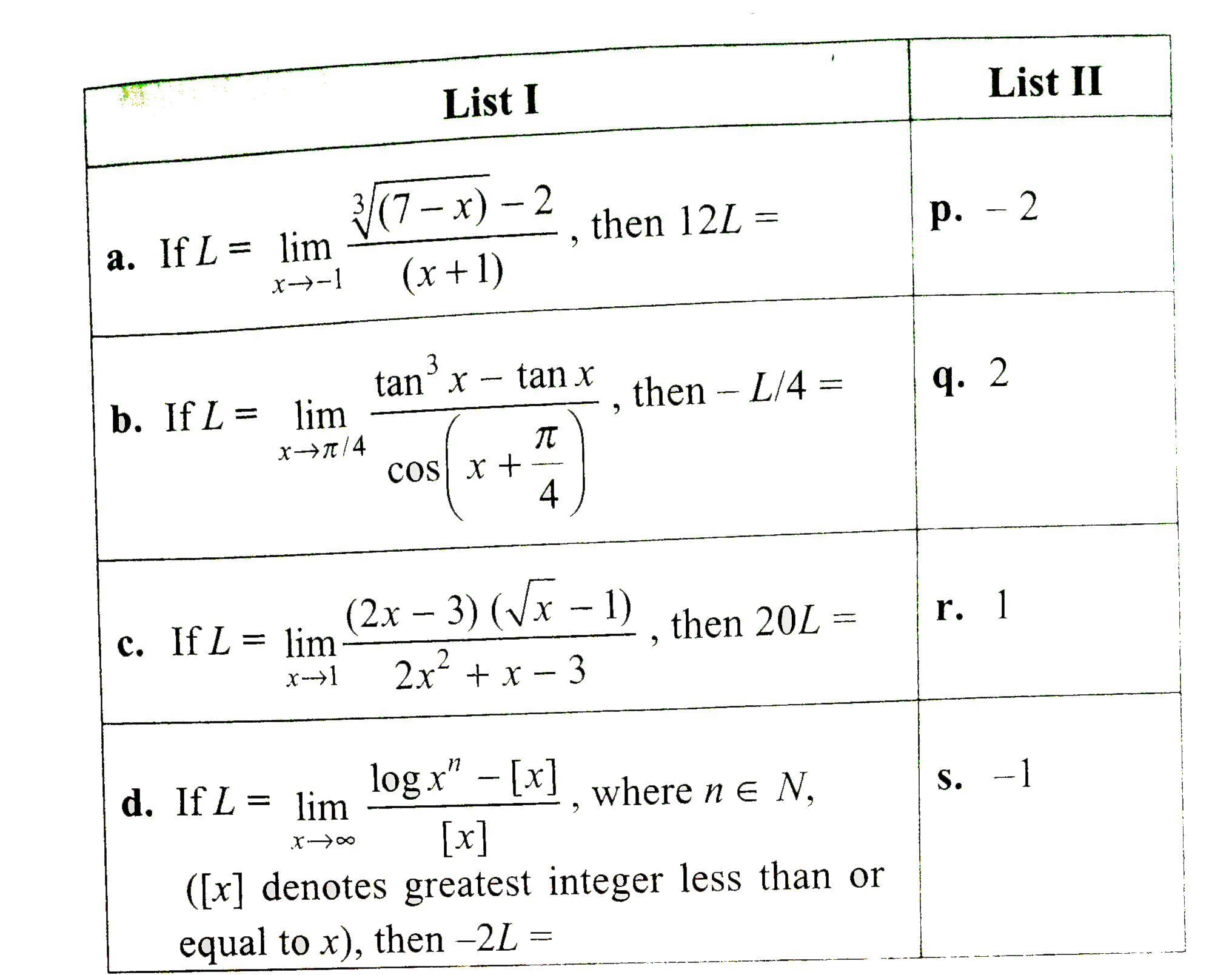The value of (lim)x→1(p1−xp−q1−xq),p,q,∈N, equal p+q2 (b) pq2 (c) p−q2 (d) √pqSolution in Bengali
−34
0 if n is even
−34 if n is odd
none of these
The correct Answer is:C
=limx→1p−q+qxp−pxq1−xp−xq+xp+q (00)
=limx→1pqxp−1−pqxq−1−pxp−1−qxq−1+(p+q)xp+q−1 (00)
(L'Hospital's rule)
=limx→1pq(p1)xp−2−pq(q−1)xq−2−p(p−1)xp−2−q(q−1)xq−2+(p+q)(p+q−1)xp+q−2
(L'Hospital's rule)
=p−12
Topper's Solved these Questions
- LIMITSBOOK - CENGAGE PUBLICATIONCHAPTER - LIMITSEXERCISE - Linked Comprehension Type
20 Videos
- LIMITSBOOK - CENGAGE PUBLICATIONCHAPTER - LIMITSEXERCISE - Matrix Match Type
5 Videos
- LIMITSBOOK - CENGAGE PUBLICATIONCHAPTER - LIMITSEXERCISE - EXERCISE 2.8
8 Videos
- JEE 2019BOOK - CENGAGE PUBLICATIONCHAPTER - JEE 2019EXERCISE - Chapter 10
8 Videos
- LINEAR COMBINATION OF VECTORS, DEPENDENT AND INDEPENDENT VECTORSBOOK - CENGAGE PUBLICATIONCHAPTER - LINEAR COMBINATION OF VECTORS, DEPENDENT AND INDEPENDENT VECTORSEXERCISE - DPP 1.2
10 Videos
Similar Questions
Letf(x)=sin−1(1−{x})×cos−1(1−{x})√2{x}×(1−{x}), where {x} denotes the fractional part of x.
L=limx→0−f(x) is equal to
View SolutionMatch the following lists:

View SolutionEvaluate limx→1cosπ2x1−√x
View SolutionIf y = y(x) is the solution of the differential equation, xdydx+2y=x2 satisfying y(1) = 1, then y(12) is equal to
View SolutionThe number of integral values of p for which (p+1)ˆi−3ˆj+pˆk,pˆi+(p+1)ˆj−3ˆk and −3ˆi+pˆj+(p+1)ˆk are linearly dependent vectors is q
View SolutionThe value of p and q for whichp,q are the roots of the equation x2+px+q=0 are
View SolutionThe value of limx→1(p1−xp−q1−xq),p,q,∈N, equal (a)p+q2 (b) pq2 (c) p−q2 (d) √pq
View SolutionIf x=√p+q+√p−q√p+q−√p−q find the value of qx2−2px+q
View Solutionif |x|<1 then d(dx)[1+(p)/(q)x+(p(p+q))/(2!)((x)/(q))^(2)+
View SolutionThe roots of the equation (q−r)x2+(r−p)x+p−q=0 are (A) r−pq−r,1 (B) p−qq−r,1 (C) q−rp−q,1 (D) r−pp−q,1
View Solution(p+1q)p.(p−1q)q(q+1p)p.(q−1p)q=(pq)x then x=
View SolutionP∗q=p2−q2
p$q=p2−q2
p$q=p2+q2
p∘q=pq+p+q
pΔq = Remainder of pq
p©q = greatest integer less than or equal to pq.
If p=8andq=10 , then the value of [(p$q)Δ(p∘q)]∗[(q∗p)∘(q©p)] is :
View SolutionP∗q=p2−q2
p$q=p2+q2
p∘q=pq+p+q
pΔq = Remainder of pq
p©q = greatest integer less than or equal to pq.
If p=15andq=25, then the value of the expression [(q∗p)∘(p$q)] is:
View SolutionThe value of limx→1(p1−xp−q1−xq),p,q,∈N, equal (a)p+q2 (b) pq2 (c) p−q2 (d) √pq
View SolutionThe value of p and q(p≠0,q≠0) for whichp,q are the roots of the equation x2+px+q=0 are (a)p=1,q=−2 (b) p=−1,q=−2 (c) p=−1,q=2 (d) p=1,q=2
View Solutionयदि p तथा q भिन्न वास्तविक संख्याये है, तो 2{(x−p)(x−q)+(p−x)(p−q)+(q−x)(q−p)}=(p−q)2+(x−p)2+(x−q)2 सन्तुष्ट होगी
View Solution
